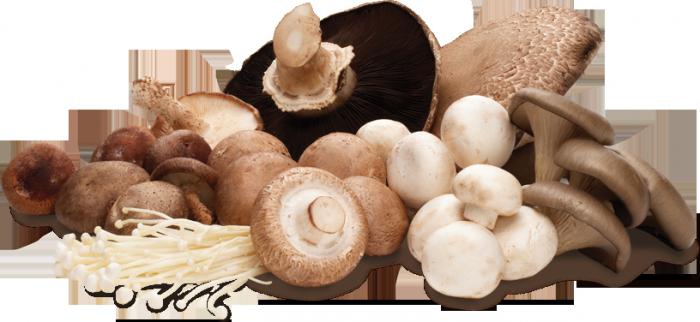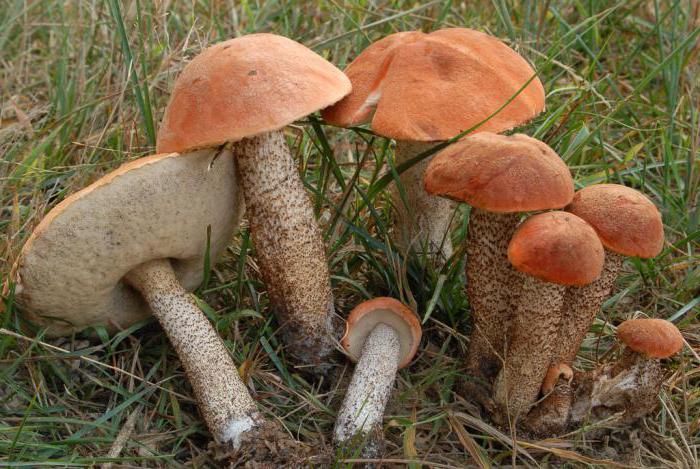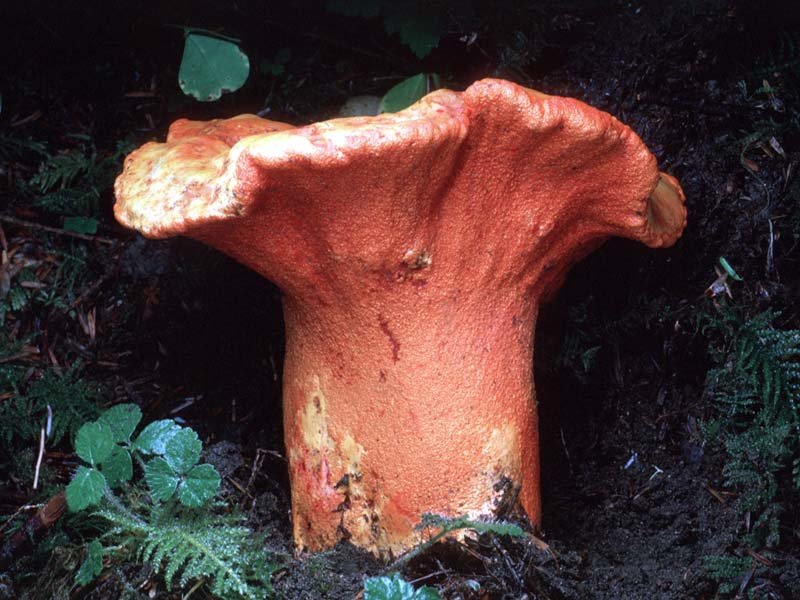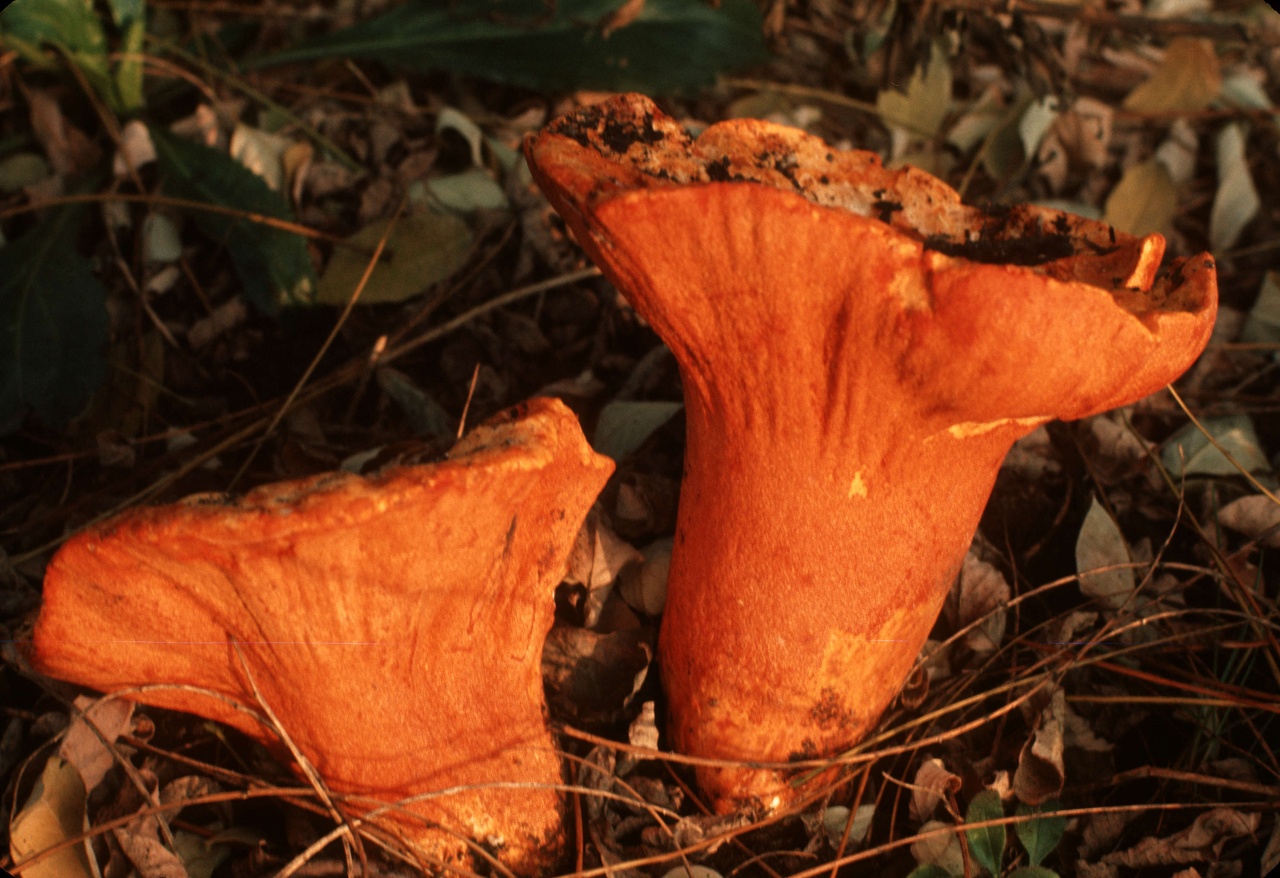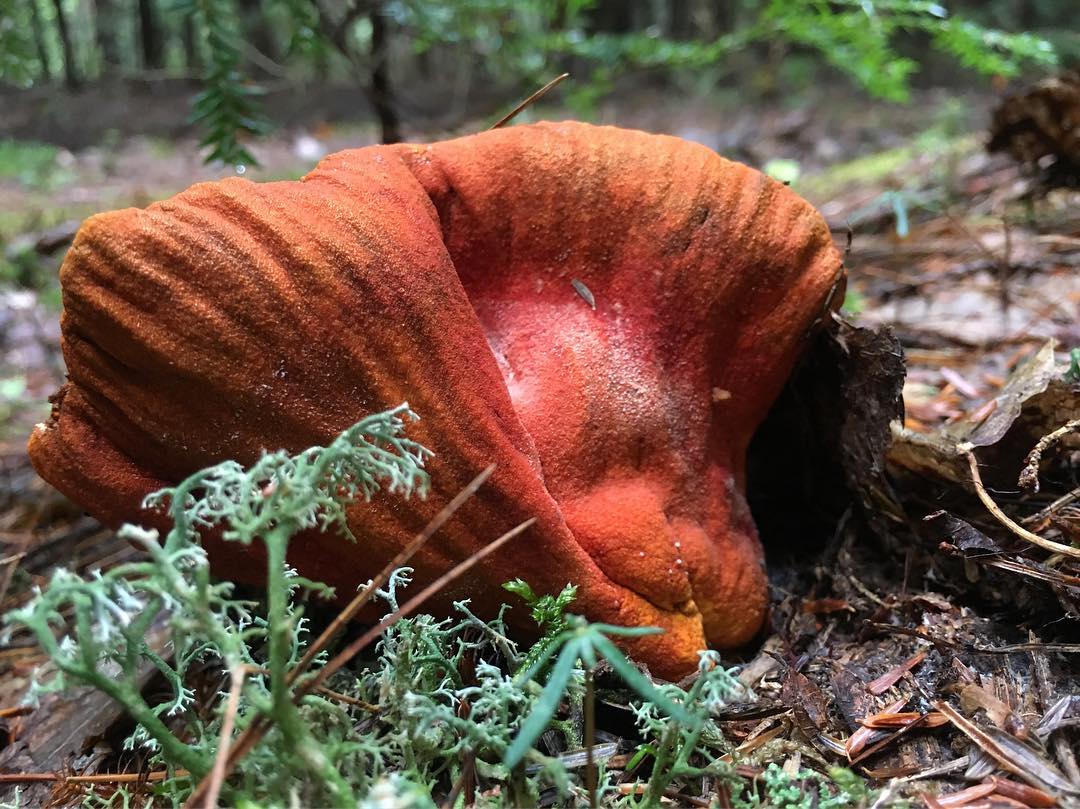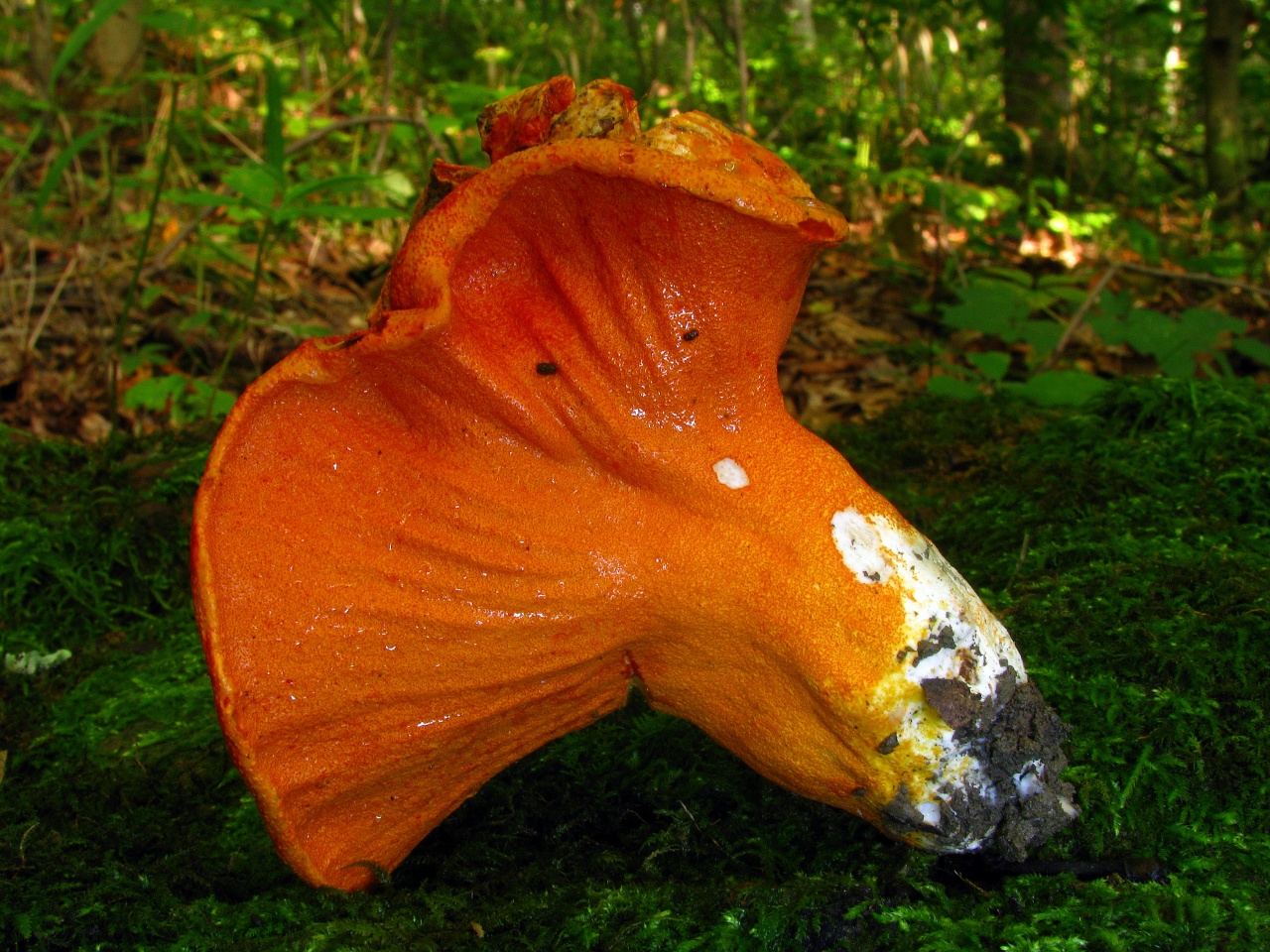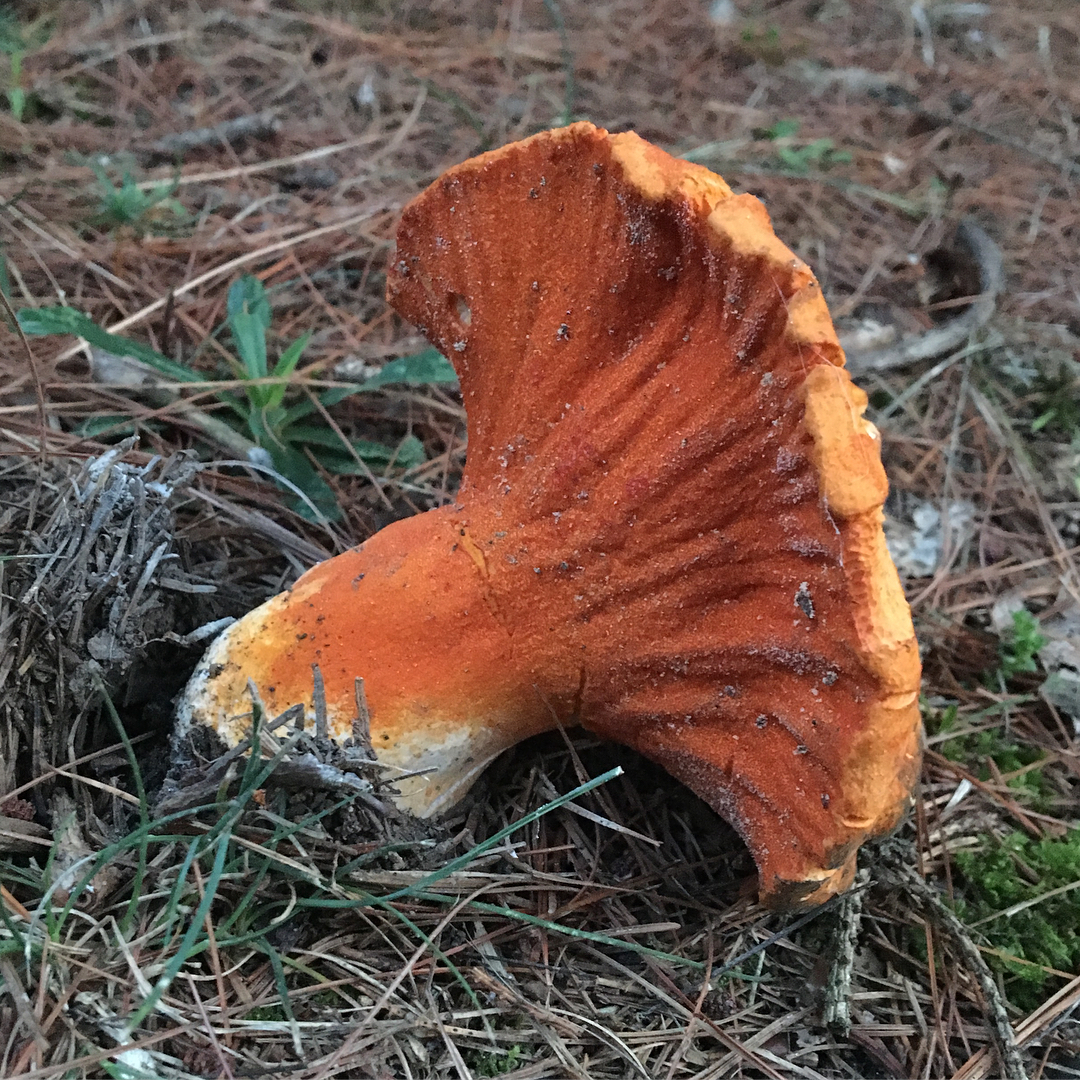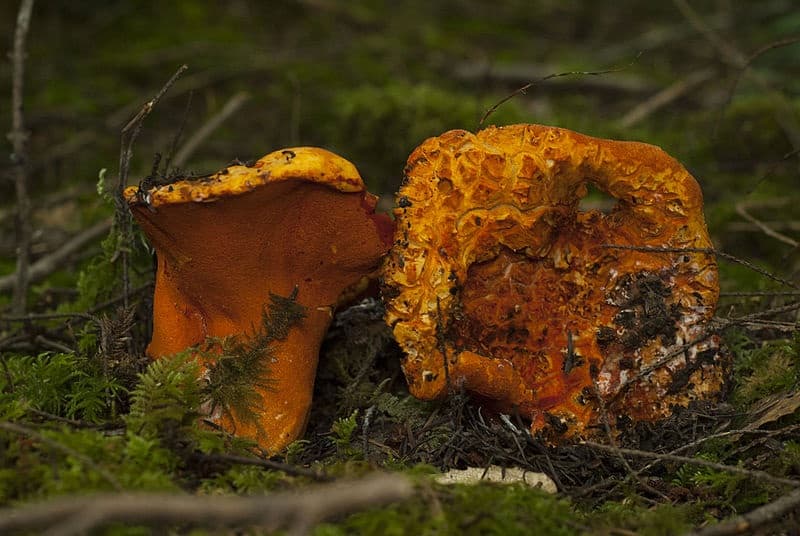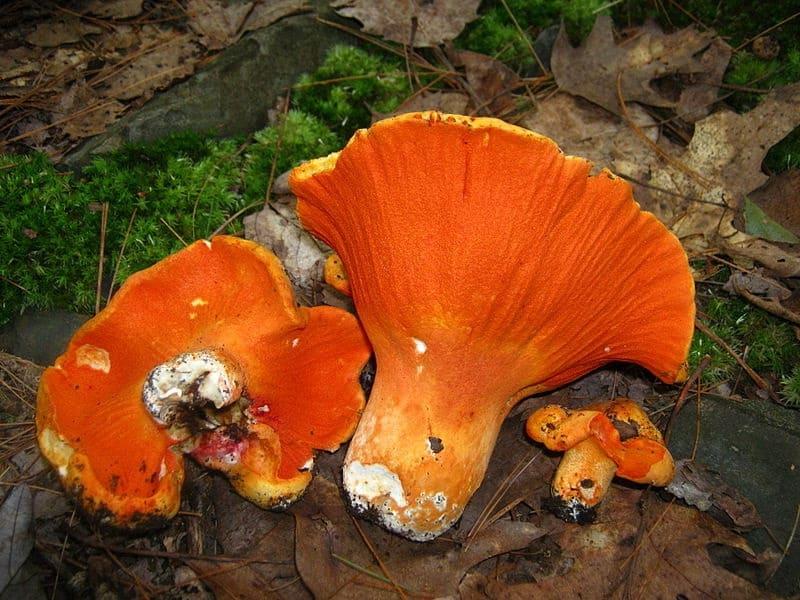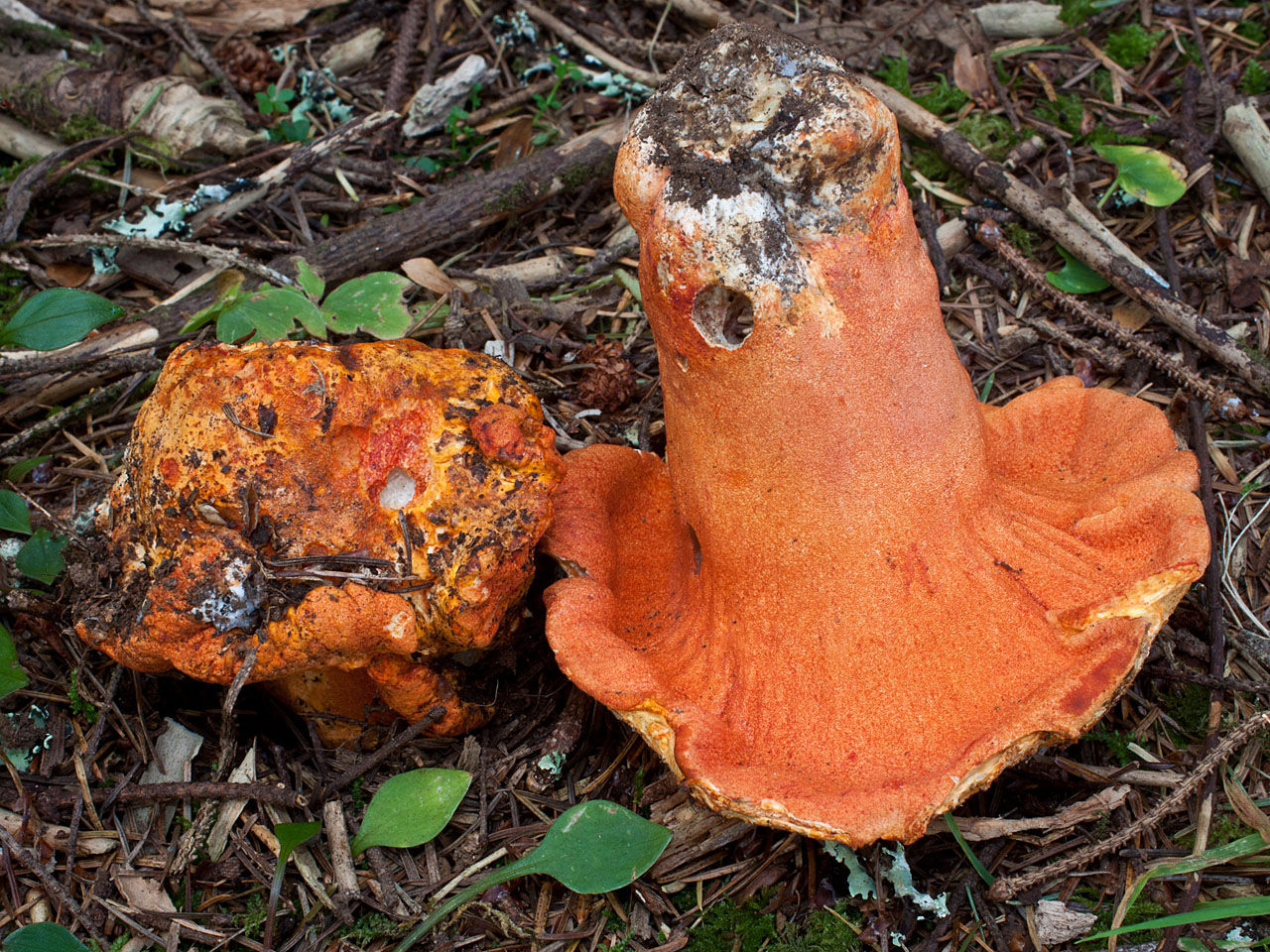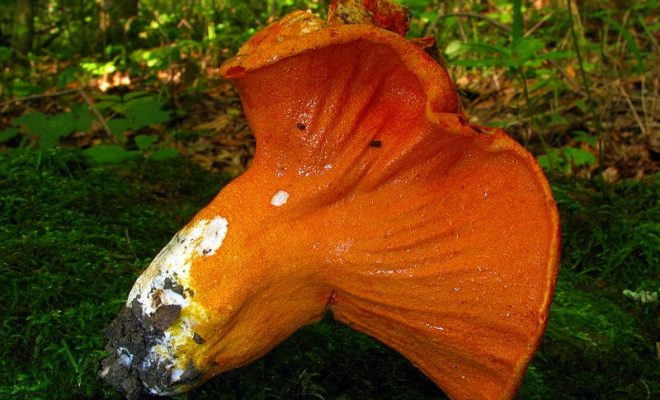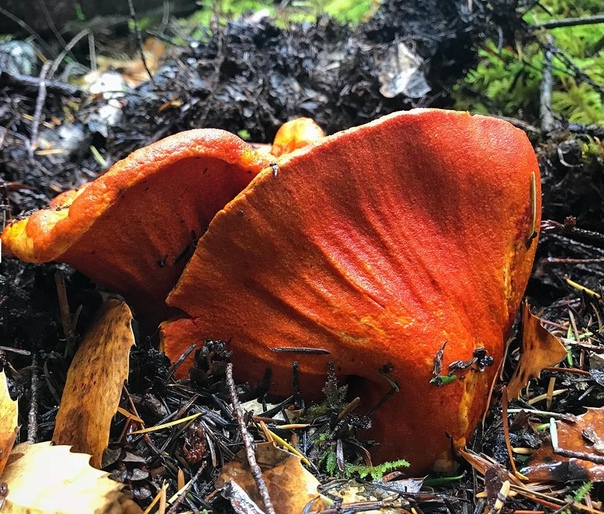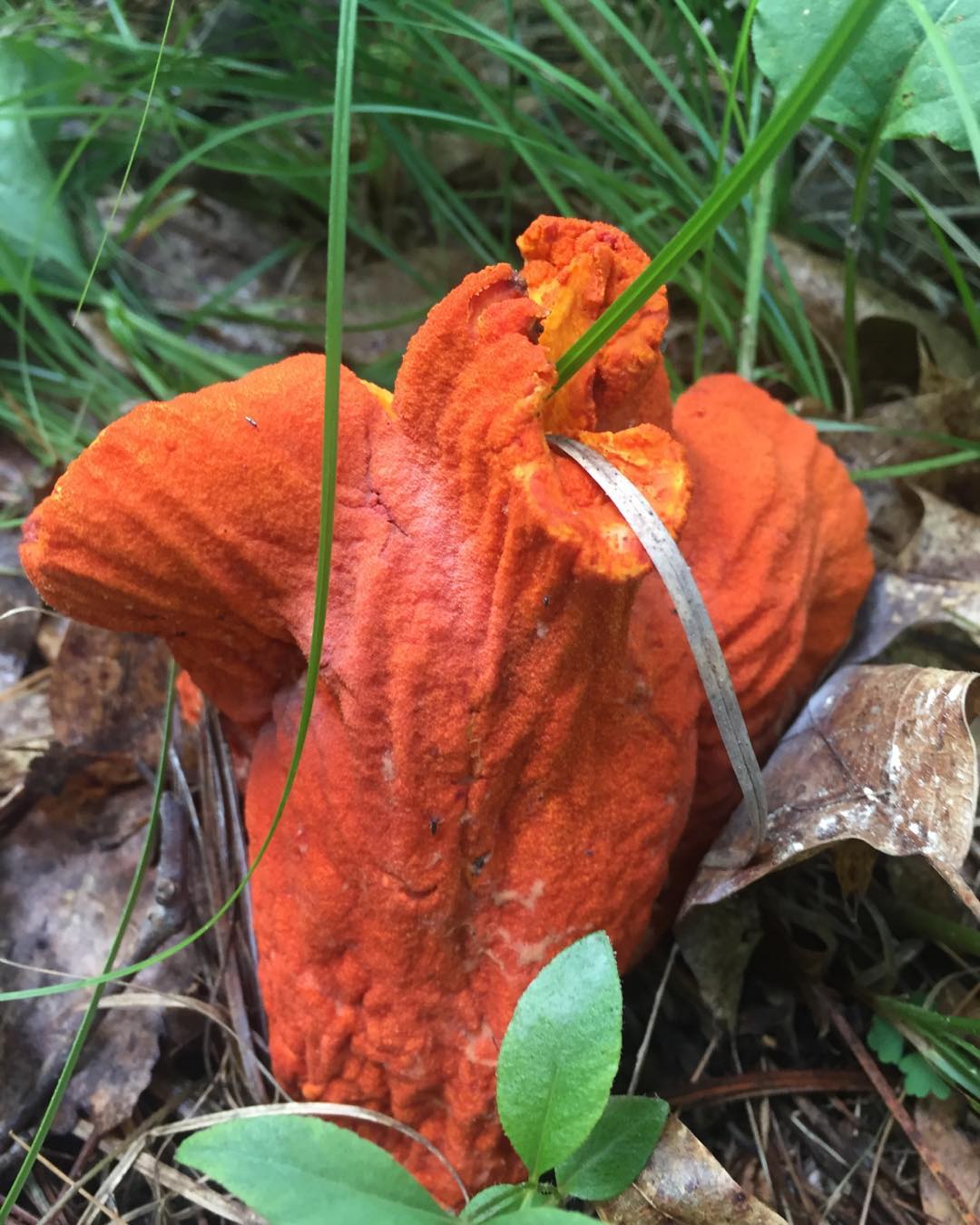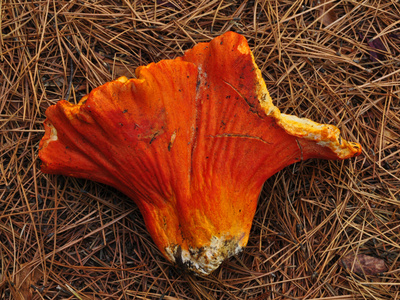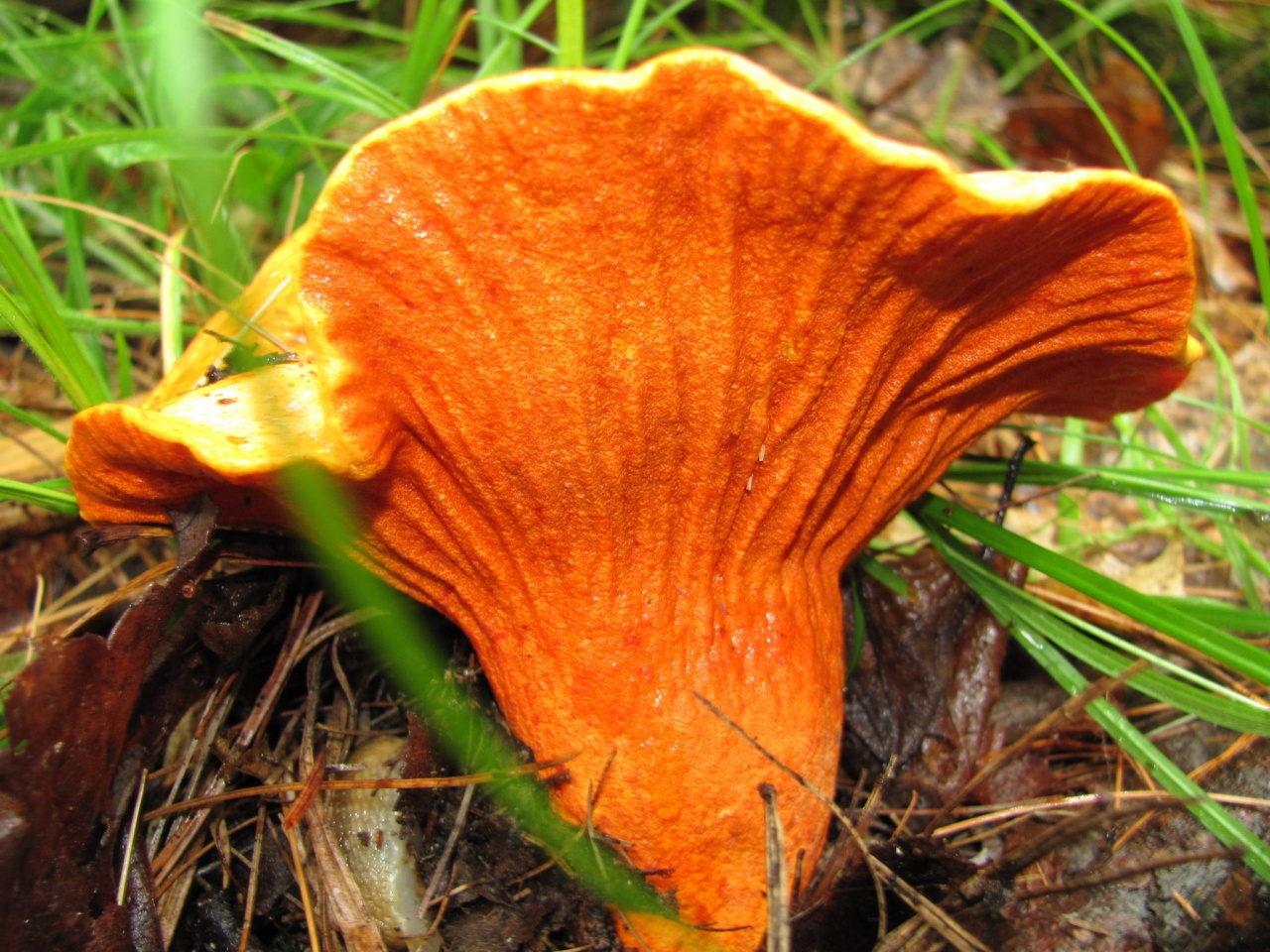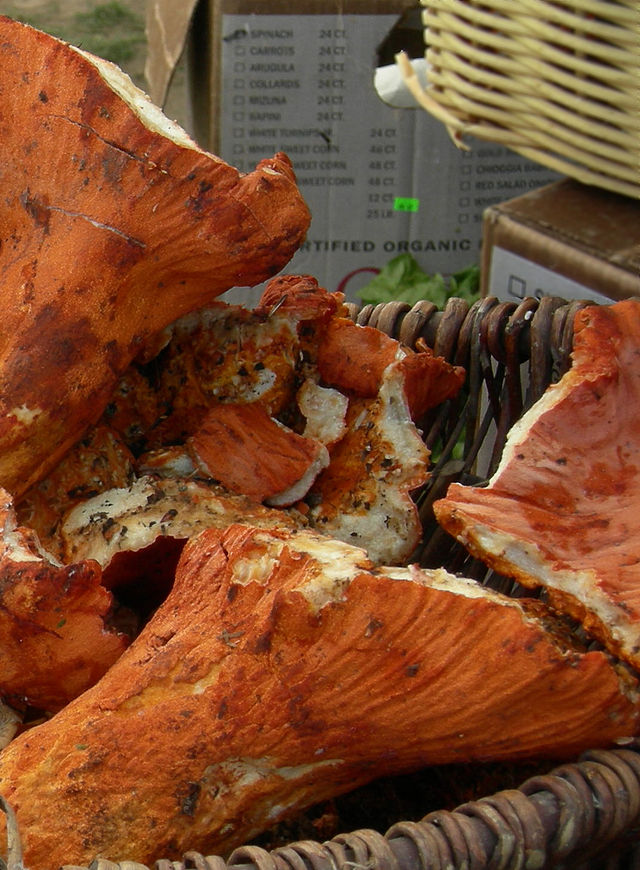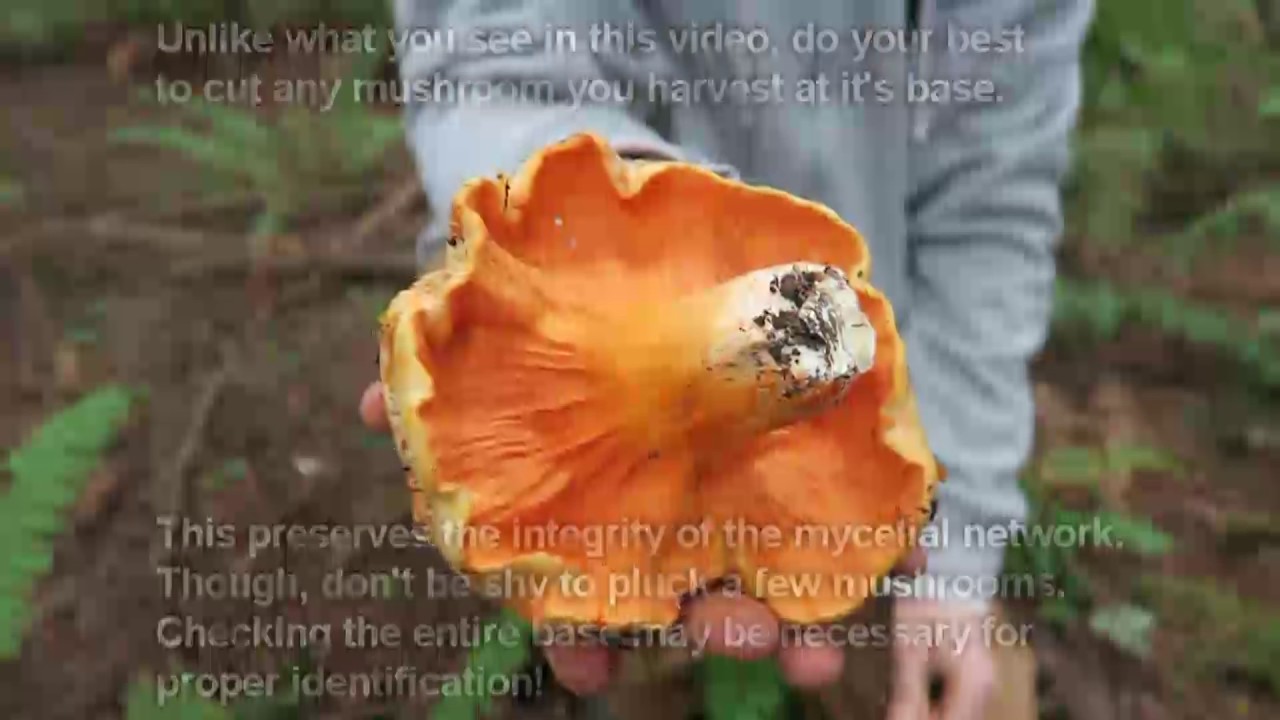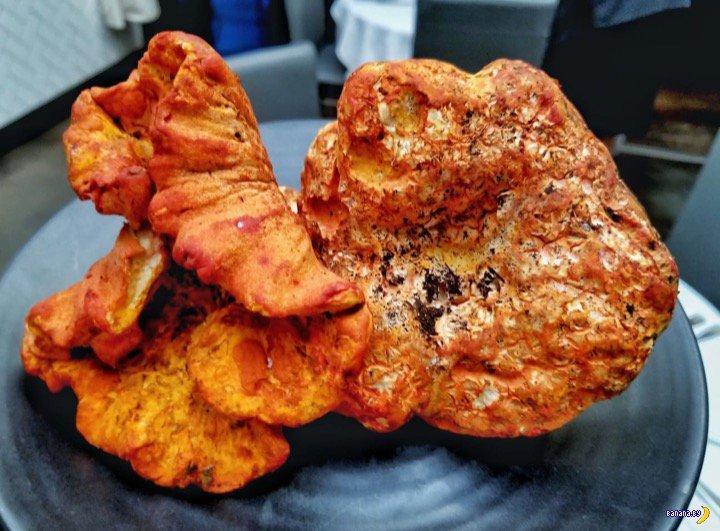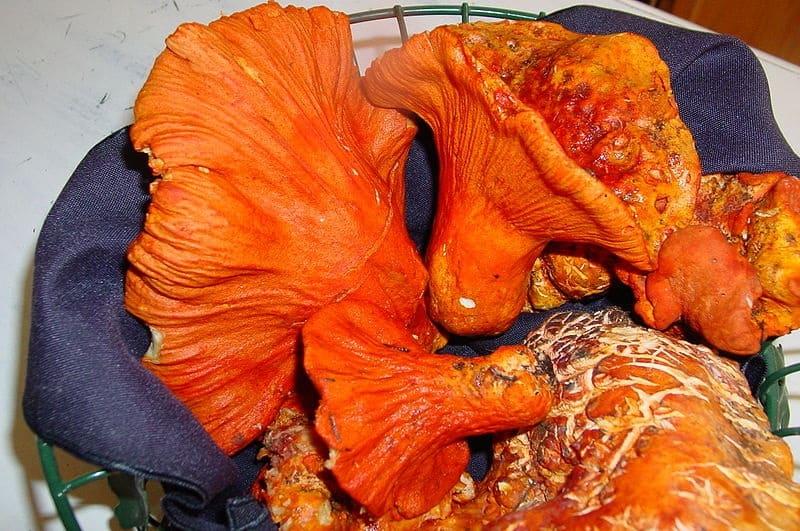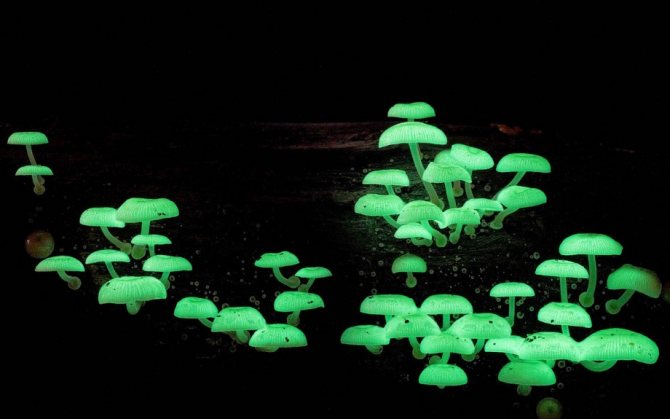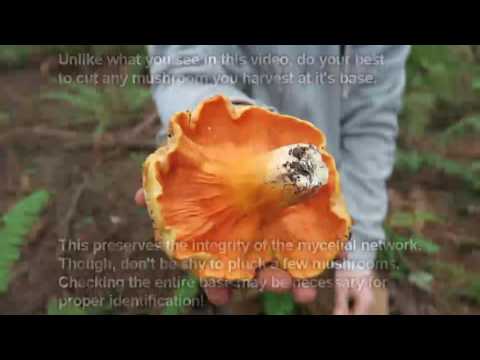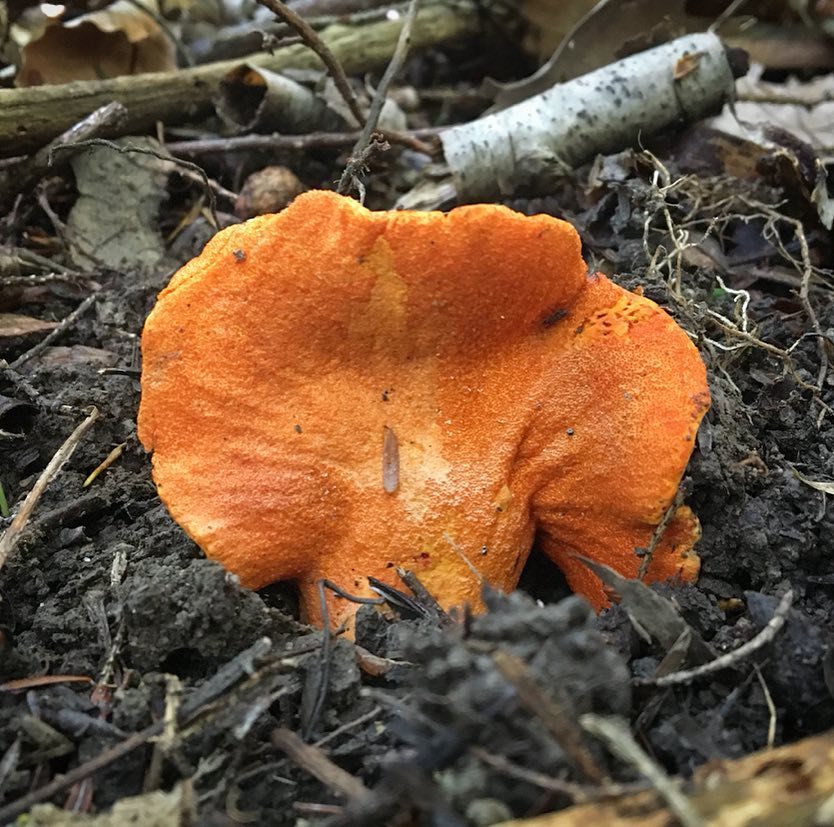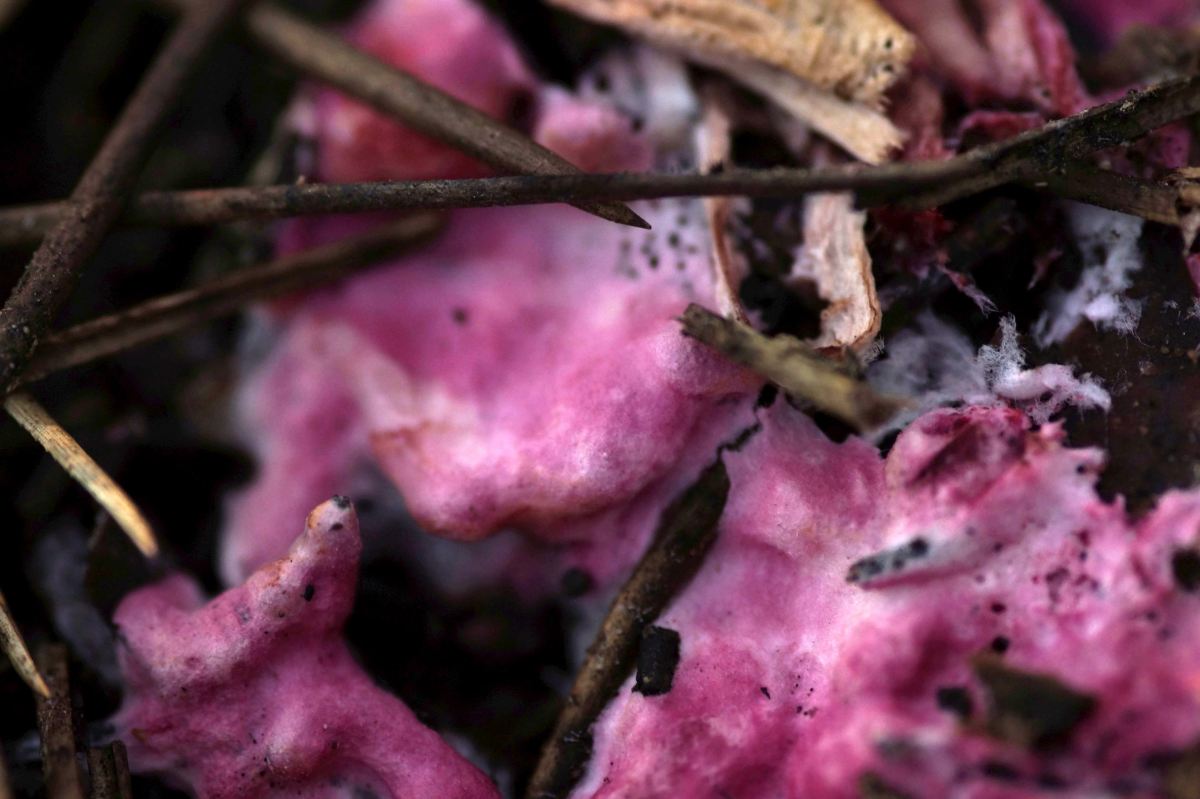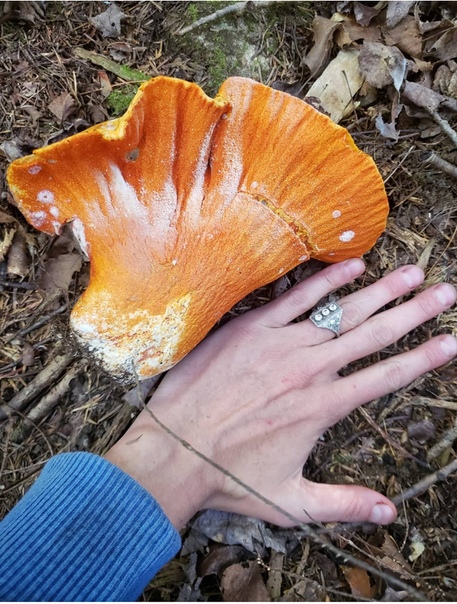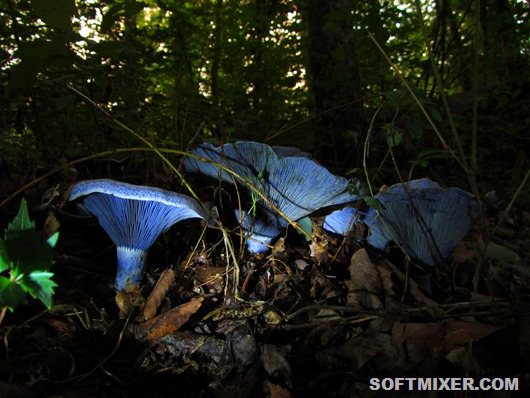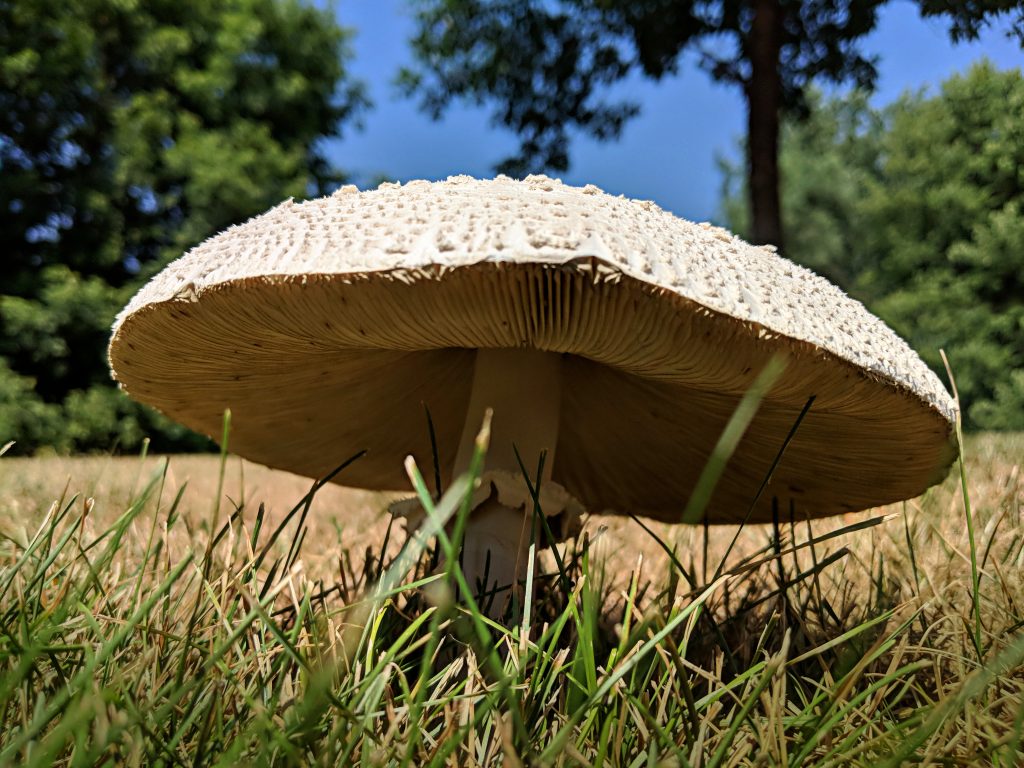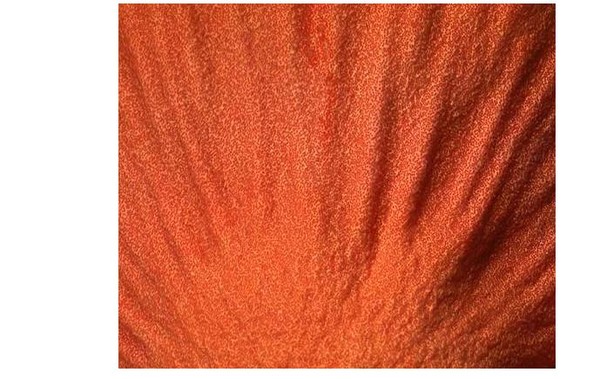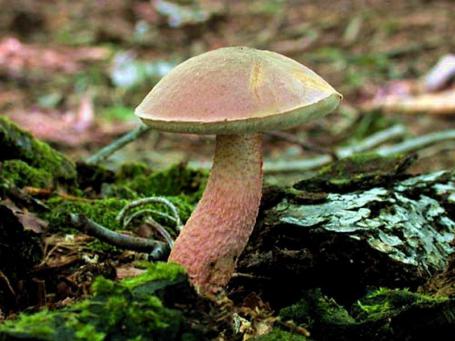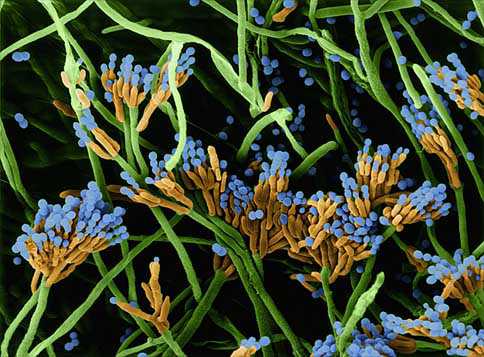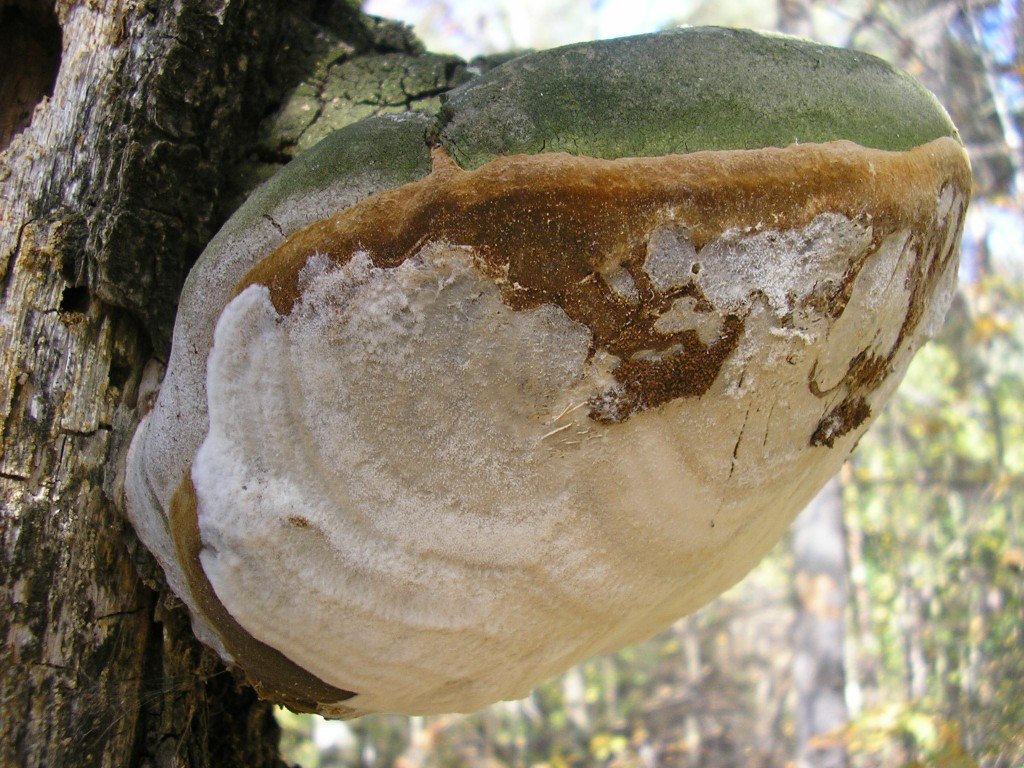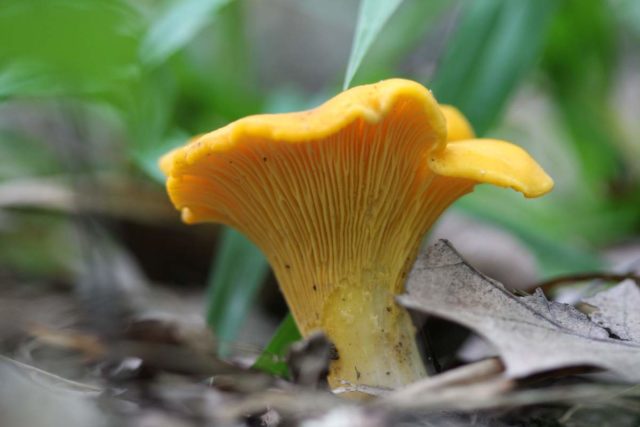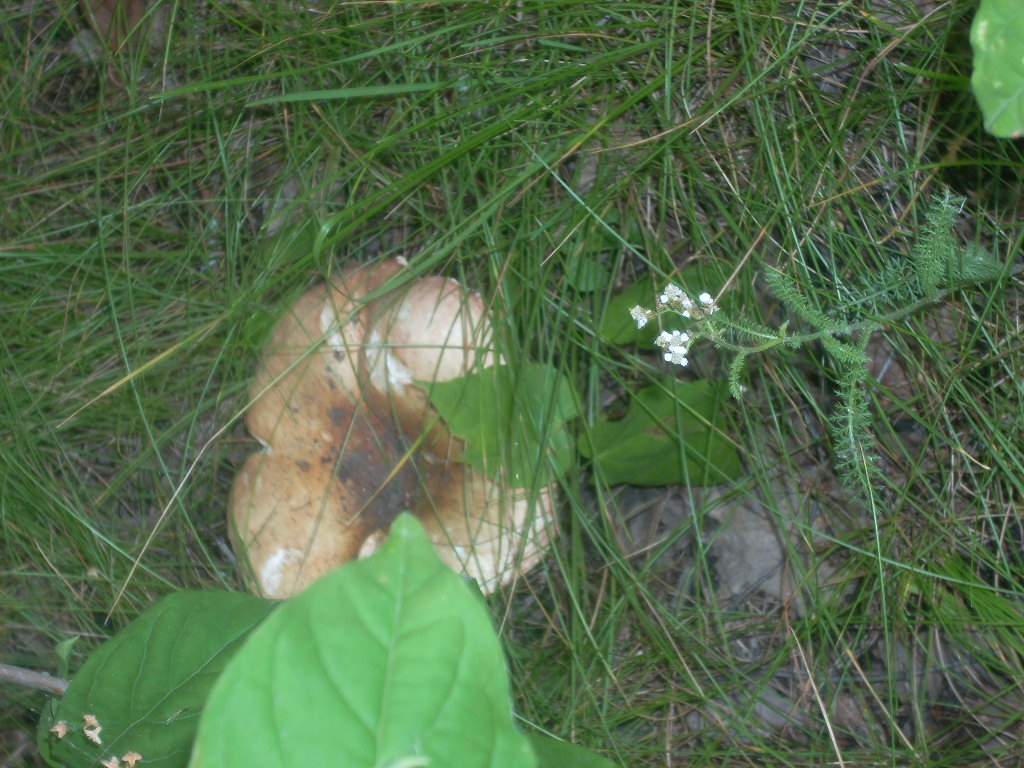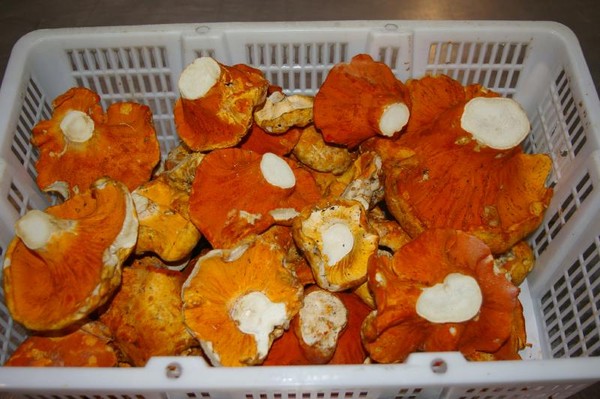The Mutant Mushroom Case
Episode 1. Hot and wet July, collecting spruce mushrooms. Thorny wet paws are just waiting for a man to bend down to pick up a mushroom to pour half a bucket of cool water onto his collar. A gust of wind - and the feeling as if the spruce is shaking off, like a bathed dog ... And all by my collar. But it was worth it - a family of "deaf" saffron milk caps grew on a small clearing. From a distance you can see - massive, twisted, pleasantly ugly. The locals neglect them, but I'm looking specifically for them: tasty, not wormy at all even in the height of summer ...
Our Russian hypomyces on spruce mushroom (photo by I. Lebedinsky)
Episode 2. Same time, same heat and dampness. In a broad-leaved forest, where the gloom from closed crowns does not let a blade of grass fall on the black loose soil, white figures of mossweed are lined up. It seems that the mushrooms have turned into moldy statues, frozen in space and time. They fled from the mushroom Sodom, but could not stand it, threw a farewell glance at the kingdom of forbidden pleasures, and froze forever ... Around one generation of Mossworms replaces another, and these are standing and standing. I will not disturb them ...
Mokhovik, who became immortal from hypomyces (photo by Olga Gubanova)
Episode 3 (reconstruction by the author). Canada, Ontario. Broadleaved forest. Hot, damp. Cheerful mustachioed fat men in baseball caps (this is how I imagine American mushroom pickers, excuse me) recklessly collect some grotesque mushroom-shaped objects of unexpected red color, like boiled crayfish. At first glance, it may seem as if this is some kind of game: the presenter has placed brightly colored dummies of mushrooms in the bushes, and the participants collect them for speed, but it does not smell like a game. But it smells like, yes, boiled lobster ...
But these are overseas lobsters (photo from open sources)
What do these three episodes have in common? They are united by their main participant in the events: a moldy fungus from the genus Hypomyces (hypomyces). Each time, of course, it is different. American russula and lactarius turns into a delicious "lobster" lactic hypomyces (Hypomyces lactifluorum). Tubular fungi, especially mushrooms, are usually eaten on the root by Hypomyces chrysospermus. Unlike the first, he does not turn his victims into delicacies at all - on the contrary, tubular mushrooms overgrown with moss are considered weakly poisonous. Finally, the third (as well as the fourth, fifth and tenth) species of hypomyceses affects our bedside mushrooms and waves, enveloping their plates and protecting them from the ubiquitous mushroom flies ... They write that brick-red hypomyces (Hypomyces lateritius) took responsibility for this matter, but he is hardly the only one involved. Most likely, there are accomplices.
Where does hypomyces lactic acid grow?
Distributed throughout North America. Found in mixed forests in the USA, Canada and Mexico. It parasitizes on mushrooms of the russula family, which include different types of russula and milkweed. Often found on milk mushrooms.
Hypomyces lactic acid appears usually after heavy rains, does not bear fruit for long. After the parasite colonizes, the "host" stops its development, and spores cease to form.
It is found only in the wild in conjunction with other species on which it can parasitize. It is not displayed artificially. Fruiting from mid to late July to September.
It is very popular in places where it is common. In the United States, lobster mushrooms are sold dried. They can be purchased at farmers' markets and in some shops. Their price exceeds that of dried whites. They are exported to countries in Europe and Asia, especially Japan and China, where they are considered an exotic product.
Types of molds and their description with photos
Molds are called micromycetes. They have a microscopic structure, represented by a very thin multi-row mycelium body.The body is branched, rarely contains septa, is the base of the multinucleated mycelium. Details of the structure can be seen in the photo.
The characteristic features of the Mold are the following:
- The mycelium is the basis of the vegetative body - filamentous branched hyphae.
- Large size of mycelium.
- Mycelium, unlike yeast, is divided into cells.
- The possibility of reproduction in three ways: vegetative, asexual, sexual.
There are several classifications of mold. The most commonly used classification by color (mushrooms are white, yellow, black, green, brown, red) and classification by the number of cells.
According to the number of cells, mold is divided into 2 types: zygomycetes and ascomycetes. Zygomycetes are a small group of unicellular fungi. Ascomycetes are multicellular.
Mycologists distinguish 4 genera of Molds:
The genus Aspergill has several hundred species. Its mycelium has septa characteristic of higher fungi. Initially, the mold is white in color, but as it grows, it acquires a wide variety of shades. Reproduction of Aspergillus species occurs in the traditional asexual way, but some higher species are capable of sexual reproduction.
Many Aspergillus species are hazardous to human health. They can provoke serious illness in people. Various types are actively used in the food industry and medicine.
Botrytis is popularly called gray mold. Myceliums form dense, colorless colonies, which, due to their density, acquire a gray smoky shade. Representatives of Botrytis are unicellular fungi that colonize soil and plant debris.
Hyphae are visible to the naked eye. Species of this genus are very variable, so they can take on a wide variety of forms. Representatives of Botrytis are irreplaceable in winemaking. They are not particularly dangerous to humans. Botrytis species can be affected by hyperparasitic fungi.
Penicillus is considered a noble mold. It is actively used in traditional medicine, as well as in cheese making and sausage production. There are 4 species groups of the genus Penicillus:
- velvety;
- felt;
- bundle;
- species with koremias.
Species of the genus Penicillus settle in soil, water, air. Many of them prefer plants and foods. The color of the mold changes depending on the species. Most often it is white, yellow, orange or brown. Less common specimens of red and black shades.
Hypomyces lactic acid is an edible mold. This genus of Molds settles on edible mushrooms - russula and lactarius.
Hypomyces lactic
Mold initially appears as a thin coating of bright red or bright orange. Then, perithecia begin to form on it - bulbous bodies that can be viewed through a magnifying glass.
Hypomyces lactic acid is considered a delicacy. Mushroom pickers call it mushroom lobster for its color reminiscent of boiled lobster, smell and taste comparable to seafood. Mushroom lobster is not just consumed as food - a real hunt is arranged for it. This species poses absolutely no threat to human life and health.
What does hypomyces lactic acid look like?
At first, it is a bloom or film of bright orange or red-orange color. Then, very small fruiting bodies in the form of a bulb are formed, which are called perithecia. They can be seen through a magnifying glass. The carrier fungus colonizes gradually, and as a result it becomes completely covered with a bright reddish-orange bloom. It becomes denser and deformed, the plates on the underside of the cap are smoothed out, and its shape can become very bizarre. It is almost impossible to confuse it with any other species.
"Lobster" can reach impressive sizes
The color of the mushroom on which it parasitizes resembles boiled lobsters. Thanks to this, it got its name.
The spores of hypomycetes are lactic white, fusiform, warty, very small in size.
The mold parasite not only changes the color of the host, but also significantly deforms it
Cooking recipes
From this type, you can cook many delicious, unusual dishes and diversify your diet.
Cleaning
How to clean lobsters properly:
- Rinse them under running water.
- Pry the skin with a knife and remove it.
- Remove traces of decay.
- Rinse well again, dry.
Cooking
Boil the peeled mushrooms in salted water for 20-25 minutes. It is always recommended to do this before any culinary treatment.
Pickling
Ingredients:
- 2 kg of mushrooms;
- 1 liter of water;
- 60 ml vinegar;
- 2 tbsp. l. salt;
- 1.5 tbsp. l. Sahara;
- 1 tsp black peppercorns;
- 2-3 pcs. carnations.
Step by step cooking
- Sterilize the jars.
- Boil the mushrooms over medium heat until they settle to the bottom.
- Pour the broth into another saucepan using a colander.
- Rinse the lobsters with cold or cool water.
- Add the broth with salt, sugar, pepper and cloves, boil.
- Add mushrooms to the marinade and cook for 7 minutes.
- Cook with vinegar for another 5 minutes.
- Fill the jars with mushrooms boiled in the marinade.
- Cover with boiling brine.
- Roll up the cans with metal lids.
Freezing
Large, dry and crumbling, rotten specimens are categorically not subject to this procedure. It is better to freeze fewer mushrooms, but better quality and stronger in shape.
Would need:
- Clean the mushrooms from grass and dirt, wipe with a napkin.
- Spread out on a tray and place in the freezer for 15 hours.
- Distribute into containers and packages.
- Send it back to the freezer.
Frying
In this recipe, you cannot use fresh garlic, which will only spoil the taste of the dish. Choose a canned vegetable or a spice.
Ingredients:
- 0.5 kg of lobsters;
- 100 g lard with meat layer, cut into small pieces;
- canned garlic;
- salt and freshly ground black pepper to taste;
- 1 tbsp. l. chopped parsley;
- 1 tbsp. l. oregano spices.
Step by step cooking
- Wash, dry and chop the mushrooms.
- Place the bacon over medium heat and cook for 5 minutes. Add mushrooms and garlic and cook for 8 minutes until the liquid evaporates.
- Sprinkle with salt and pepper at the end of cooking.
- Add parsley and oregano to the finished dish.
Salting
Too large "lobsters" are not suitable for pickling. Give preference to undamaged medium to small mushrooms. They are salted much faster.
While searching for mushrooms, experienced lovers of quiet hunting immediately notice and remove all kinds of forest debris in the form of adhered blades of grass and leaves. It is almost impossible to remove sand by hand, but it is easy to do with a toothbrush. Then they are dipped in a container with plenty of water.
It is advisable for lobsters to "take" a sour-salt bath for the next day. The proportions are calculated as follows: for one liter of water, take 2 g of citric acid and 10 g of rock salt. Finally, you need to thoroughly rinse the contents of the container.
It is recommended to fill in enamel buckets, glass jars and barrels. Clay and zinc dishes will not work, as the salt will remain on the walls.
Per kilogram of mushrooms you will need: 125 ml of water, 2 tablespoons of salt (regular, without iodine), bay leaf, a head of garlic, dill umbrellas, vegetable oil (depending on the size of the container).
Step by step cooking
- Cut off the caps and pour boiling water over them.
- Peel the garlic, finely chop the cloves.
- Place 2 dill umbrellas on the bottom of the container, put half of the lobsters.
- Sprinkle 2 tablespoons of rock salt on top, half of the whole serving of garlic.
- Place these ingredients in the same order except for the rock salt and finish with 2 dill umbrellas.
- Cover with a disc slightly smaller than the diameter of the container.
- Press down with something heavy (a container with water or a special circle), leave for a day. After 24 hours, remove the disc, fill the contents with oil so that it completely covers the contents of the container.
Video
Unfortunately, lobsters are rare mushrooms, but they can be great for a healthy, nutritious diet.This variety is called "lobster" not only because of its characteristic smell, but also because in its color they resemble boiled lobster.
LAT Hypomyces lactifluorum Edible Synonyms: Lobster Mushroom
Specifications:
| Group: | Marsupials |
|---|---|
| Plates: | Absent |
| Colour: | Bright red with an orange tint |
| Info: | Smells like seafood |
Systematics:
| Department: | Ascomycota (Ascomycetes) |
|---|---|
| Subdivision: | Pezizomycotina (Pesizomycotins) |
| Class: | Sordariomycetes (Sordariomycetes) |
| Subclass: | Hypocreomycetidae |
| Order: | Hypocreales |
| Family: | Hypocreaceae |
| Genus: | Hypomyces |
| View: | Hypomyces lactifluorum (Hypomyces lactic acid) |
It's about a curious edible mushroom. What is unusual about it is that, firstly, it is a mold. And secondly, it parasitizes on other edible mushrooms, radically changing their taste. It is a pity that in Europe this unusual mold does not occur at all and our mushroom pickers are deprived of the pleasure of enjoying such an unusual delicacy.
definition - Hypomyces lactic acid
of Wikipedia
Advertizing ▼
Wikipedia
Hypomyces lactic
From Wikipedia, the free encyclopedia
Go to:.
| Hypomyces lactifluorum | ||||||||||||||
| Lobster Mushrooms and Chanterelles (Seattle Festival) | ||||||||||||||
| Scientific classification | ||||||||||||||
|---|---|---|---|---|---|---|---|---|---|---|---|---|---|---|
|
||||||||||||||
| Latin name | ||||||||||||||
| Hypomyces lactifluorum (Schwein.) Tul. & C. Tul. 1860typus | ||||||||||||||
| Synonyms | ||||||||||||||
|
||||||||||||||
Hypomyces megalithic (lat.Hypomyces lactifluorum) - a mushroom of the Hypocrein family (lat.Hypocreaceae) Department of Ascomycetes (lat.Ascomycota).Synonyms
The English name for mushrooms affected by H. lactifluorum: lobster mushrooms ("lobster mushrooms")
Description
A mold that grows on the fruiting bodies of other fungi. In the beginning it is a sterile bloom of a bright red-orange color, on which then bulbous fruiting bodies are formed - perithecia, which can be distinguished in a magnifying glass. The taste is soft or slightly pungent (if the host mushroom has a spicy milky juice), the smell is first mushroom, then resembles the smell of molluscs. Spores 40 × 4.5 μm, fusiform, bicellular, warty, white in mass.
Ecology and distribution
The fungus parasitizes various types of russula and milkweed, such as the pepperoni (Lactarius piperatus) or Russula brevipes... the affected fungus cease to develop and do not form a spore. Distributed on the west coast of North America, south to California, usually appears for a short time after rains.
Nutritional quality
"Lobster mushrooms" are edible and popular where they grow. They resemble boiled lobsters in color, for which they received their English name, their taste and aroma are also compared with seafood. Growing up on caustic milkmen H. lactifluorum largely neutralizes their pungent taste, making them completely edible.
Literature
Lesso T. Mushrooms, key / trans. from English L.V. Garibova, S.N. Lekomtseva. - M .: "Astrel", "AST", 2003. - S. 43. - ISBN 5-17-020333-0
Latin-Russian Dictionary for Biologists
M .: FLINT
The dictionary is intended to help in "decoding" both Latin names
living organisms and biological terms, includes about 3 thousand
arranged in a single alphabetical order of Latin and Greek words,
on the basis of which scientific biological Latin is built. To simplify
the perception of the material in front of the actual text of the dictionary is given the original
the author's method of meaningfully memorizing Latin and Greek words,
based on their similarity to the derivative Russian words.
Hypomyces lateritius - brick-red hypomyces (marsupial mushroom of the order of hypocraneous) lathraeos (gr.)
Preview: Latin-Russian Dictionary for Biologists.pdf (0.2 Mb)
Mold damage
Despite the benefits, molds can be very harmful. Representatives of the Aspergill family are considered the most dangerous. They are capable of infecting humans and animals. The most common are skin lesions, external ear infections, and allergic reactions. A serious illness called mycetoma also provokes this kind of mold.
The genus Botrytis can be safely called a garden pest.
Representatives of this genus cause a large number of fungal diseases in such plants:
Botrytis provokes allergies in humans.Sometimes fungal spores cause lung disease in people who are prone to respiratory disease.
Two worlds - two Shapiro
In any case, one must understand that our "deaf mushrooms" are not at all the same with overseas lobster mushrooms. Although the handwriting of hypomyces is one. Seeking out a prey at the primordial stage, hypomyces braids the developing fruiting body with its hyphae, penetrates inside and controls the further development of the fungus.
The degree of penetration and control differs depending on the type of parasite. Our hypomyces attacks mainly the plates of the fungus, leaving an even, slightly dusty place from them; the overseas species envelops the mushroom entirely. In both cases, hypomyces changes the structure of the fungal tissue - it becomes much denser and more durable, inaccessible to insect larvae. The American species has a curious property: settling on extremely caustic milkers, it transforms the bitter milky juice into something that resembles the taste of a crab. Ours is deprived of such superpowers: the waves affected by it remain superbly caustic, I have tried.
This is our deaf saffron milk cap, obviously pine. Despite the dubiousness of the form, you can vouch that the content here is excellent (photo by MiLLeNium user)
Another fact. Imported hypomyces stimulates the development of the host fungus, albeit at the expense of the slender shape. Hefty, as if hewn with an ax, "lobsters" weighing half a kilo are not a great rarity. There are also kilogram ones. Ours - alas. "Deaf" mushrooms are only slightly larger than their healthy counterparts.
In general, hypomyces is one of the few areas where America has confidently overtook us. Moon landing, blue jeans and mushroom lobster. You can't catch up with them here.
"Hypomyces golden spore" in books
Complex machine - immunity. But the more complex the car, the more likely it is to break down. Is it so?
Complex machine - immunity. But the more complex the car, the more likely it is to break down. Is it so? - This complex machine is immunity. Birth defects and old age - Yes, not easy. - But the more complex the car, the more likely it is to break down. - It
Complex machine - immunity. But the more complex the car, the more likely it is to break down. Is it so?
Complex machine - immunity. But the more complex the car, the more likely it is to break down. Is it so? - This complex machine is immunity. Birth defects and old age - Yes, not easy. - But the more complex the car, the more likely it is to break down. - It
A car
Machine What I fly through the air is called "Tu-154 medium-haul passenger aircraft." But just as in English the word “ship” is feminine, so we, pilots, talk about our own plane: “she”, “car”. Our nurse. This alone implies that we,
A car
The designer's car, like the wolf, is fed by the legs. And even if at first you can do without a car, then over time you will feel that its presence for you is becoming more and more.
A car
Car Read a rhyme to the child: In the car, in the car The driver is sitting. Car, car Goes, hums: “BBC! BBC! " First, read at a slow pace, the baby slowly turns an imaginary "steering wheel" in front of his chest and walks around the room - "rides" in a car. You shut up - baby
House and car
House and car Take two cubes, a prism and a brick. Explain to your child how you can build a house by placing a cube on a cube. Then show a "toy car" made of bricks and a cube placed on top of it. Speak all your actions. For example: "I will put a roof (prism)
One car, two cars ...
One car, two cars ... To make the time on the road go faster, you can count! You can count anything: bulbs on an escalator, men entering and leaving women, young men in red jackets. cars flashing through the window
A car
Machine For many people, the machine has become a necessary helper, friend, and even replaced home and family. You can often hear that "the car is the main wife of a man." She requires such care and attention that loved ones never receive. Where do men go - going to
A car
Machine For a machine that wants to remain mechanical and waste time, self-remembering is a hindrance. The machine would rather want the fulfillment of its desires than self-remembering, which interferes with this. P. D. Uspensky prompted us that a false personality opposes
II. A car
II. Machine Technique is of the same age as life in general freely moving in space. Only a plant, as we see it in nature, is simply an arena of technical processes. The animal, since it moves, also has a technique of movement, with
A CAR
THE MACHINE I recently spoke with an eminent scientist and inventor. He was explaining to me how to handle a new household car. I said, “Everything is fine, but the car needs to be looked after. Could you automate it so much that the housewife does not need
A car
Machine Blank Parts The machine can be divided into three parts: cylinder, spool and transmission. The spool consists of two parts - a fixed one, soldered to the cylinder, and a movable plate that controls the steam supply. The fixed part of the spool is cut out from
A car
Machine Machine - Word "M." everyone understands, but the exact definition of the concept denoted by this word has been established only during the present century thanks to the efforts of a number of scientists who have worked on the classification of the concepts of practical mechanics. Adopted in

